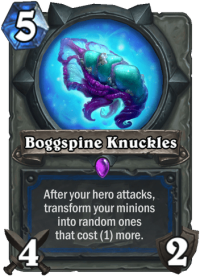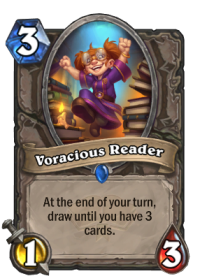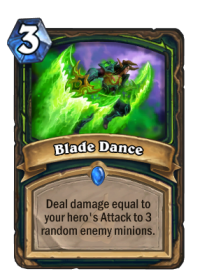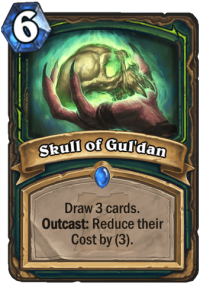For the first time in a long while, the ladder isn’t a Demon Hunter-infested hellscape. We’ve got a thorough round of nerfs to thank for that, and while the class has definitely been pushed down to midtable status, it’s still worth looking into what remains, if only to forecast what’s next for Illidan in this merry adventure we call Hearthstone.
Evolve or Die

You may have noticed there’s a new sheriff in town. You may know him as Thrall, Morgl, or some other name, but you will instantly recognize his trusty six-shooter, a copy of Boggspine Knuckles used to generate an idiotic amount of stats around turn five to completely dominate the board from then onwards.
The strat itself is nothing new and the build has indeed seen play in the pre-nerf meta as well, but its growth spurt serves as a good highlight of how one truly dominant deck can just put a lid on certain archetypes. All an Evolve Shaman player needed to stabilize against Aggro Demon Hunters was just a little bit of extra time – exactly what the double nerfs to Dreadlord's Bite and Voracious Reader offered. It was enough to flip the meta upside down.
You may instinctively scoff at one mana nerfs but if you look at the cost change on a percentage basis, you’ll find that it actually amounts to a pretty massive downgrade in most cases – as many of the former monster cards stuck in the dumpster could demonstrate. The twin nerfs were enough to tame Demon Hunters’ aggressive setup, and while the deck still remains viable, it’s gotten just a little bit too slow to consistently get away with having absolutely no top end to speak of.

For close games, the loss of two damage per Dreadlord's Bite adds up, both in the face race and the early removal of a 4-health minion. Meanwhile, the extra mana tacked onto Voracious Reader doesn’t just mean that it takes one more turn to set up the redraw: crucially, it also makes it more difficult to empty out your hand. Still, it remains the engine of choice over Acrobatics, and the post-nerf aggro builds look remarkably similar to the previous ones – indeed, featuring both of the aforementioned nerf subjects.
There’s one more card to discuss here: Lorekeeper Polkelt and its interesting application in Aggro Demon Hunter. Even for such a specialized effect, the fact that had a vanilla body (hello Chillwind Yeti) didn’t feel like an issue, more like an insurance that playing it won’t bring along a crippling tempo loss as it was clearly designed to set up late game bombs or specific combo finishers. However, the relatively low price had the added benefit of enabling a specific draw order very early on in the game for this particular class and archetype, guaranteeing an on-curve Skull of Gul'dan, which then leaned nicely into a 1-cost Altruis the Outcast and a bunch of costless tools to enable some truly disgusting plays as early as turn seven. The small disruption to the curve means a lot here, especially for a deck that could otherwise reliably plop down a 1-drop alongside it on turn five.
Removing the Removal

Though my take on Blade Dance was that the card just simply shouldn’t exist, its nerf to three mana alongside the much more crippling change to Shardshatter Mystic pretty much lobotomized the Soul Demon Hunter archetype, which I guess will have to do for now. Blade Dance still remains relevant in the other slow deck of the class (we’ll get back to it in a moment), but losing the ability to clear an early board on turn three at the cost of a small conditional text is a massive downside. There’s no data on HSReplay for Soul Demon Hunter in top 1000 Legend at the time of writing, and the other deck has completely cut the Soul Fragment package for a more potent finisher.
I’ve teased it long enough: the new star of the show, if you can call it that, is the Il'gynoth OTK build which a few players managed to pilot to high Legend but has an otherwise quite poor global winrate.
Its popularity highlights a key issue with Demon Hunter’s design: much like Hunter, it’s incredibly difficult to enable a slow archetype for the class. Any potent removal tool (especially in the form of weapons) will slot right into aggressive builds, an insult to injury considering how this OTK finisher now seems to be the desired payoff for slower decks going forward. Right now, the class can’ t really win a game of Hearthstone without pumping out a few bursts of massive damage with direct attacks, severely limiting the design opportunities to work with.

High curves just don’t function with Outcast while low curves and cheap cycle options will hardly provide anything new compared to what we’ve seen in the Year of the Phoenix. Let’s just say it’s tough to imagine a Demon Hunter deck where you don’t run Skull of Gul'dan. It’s a six mana draw card which made its way into every aggro deck of an otherwise quite high-powered class. Having powerful evergreen cards isn’t an issue by itself: however, it does feel like we’ll need a real sea change or some truly masterfully designed class tools in future sets if the devs want to ensure Demon Hunter doesn’t feel same-y in the future. Just remember how many monstrous cards it took to enable slow Hunter decks around the time of Kobolds and Catacombs – we certainly don’t want to be force-fed an archetype like that again.
Still, the meta is healthier than it was and the class isn’t completely crushed: a job well done by Team 5. If (for some reason) you haven’t yet had your fill of Demon Hunter this year, don’t worry, for the class is still viable and the fast gameplay and the low cost of the aggro archetype compensate for the drop in winrate if it is still your preferred approach or you’re a budget player. After all the opportunities to rampage and exact vengeance, it’s fine to be taken down a peg or two for a while. No doubt Demon Hunters will be back once again with the next release of cards. We can only hope it’ll feature a different sort of archetype instead of more of the same.
Leave a Reply
You must be logged in to post a comment.





















I appreciate everything you said about Demon Hunter but this meta is even worse. I’d rather face aggro DH and soul DH (hell, Soul Demon Hunter is fun to play) and have six classes decently competitive than have Evolve Shaman and Miracle Rogue reign supreme and six classes that are half-dead or completely dead.
#NerfBoggspineKnuckles #NerfFoxyFraud
Twitch drops for packs are enabled now for the All-Star invitational Battlegrounds event! So far 1 pack!
Ignore Flood, clearly someone got coal for Christmas. Perhaps change the title to “DEMON HUNTER, REVISITED:
ANALYZING THE IMPACT ON ILLIDAN AFTER THE NERFS” to make it crystal clear this is a analysis on Demon Hunter rather than a full meta analysis.
Great job, I’ve enjoyed these articles spotlighting a class as you have (even though I don’t really play DH). I’d love to see more of these class focussed articles/how classes change throughout the year in 2021 perhaps for a variety of classes? ????
My main issue with this meta is the near total absence of Mage, Priest, Warlock and Druid. They all have some decks around tier 2-3, but that’s pretty much it. And while I enjoy the current meta and have a blast with ETC Warrior, I wouldn’t call it healthy.
What a poor article. You say “meta is healthier than it was”, but you don’t justify why this is true. You do realize that Shaman is literally a majority of the ladder at some ranks. Yet you complained about Demon Hunter being overplayed despite it having 2-3 possible archetypes. It makes no sense why the meta is “healthier” now because people are only playing Shaman (and Rogue in Legend).
Seems like you need to get over your emotional bias against DH and think about what is good for the game. For now delete this article and think about how Aggro DH, Tempo DH, Combo DH, Broom Paladin, Highlander Hunter, Spell Mage, Secret Mage, Druid, Control Priest, and all decks that can’t answer evolve boards 4 turns in a row are unplayable now. There are far fewer playable decks now that Shaman has no weak matchups, they nerfed every aggro deck and you call that healthier.
Merry christmas
This is so true. I don’t feel the nerf of DH not because I do not play that class but because the ladder is full of shaman, wich have 0 weakness. I have not been able to play and grind because of the super control board and aggro of them. I cant believe that the only way i have to grind right now is play shaman like the 80% of people. Is annoying how they always put a class too OP that everyone start playing it and then the meta get overwhelm by 1 (ONE) CLASS and deck. LIkee whats the point? where is the balance?